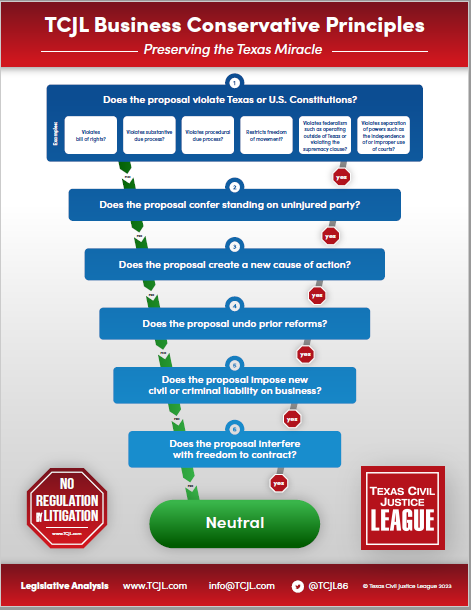 In re Waukesha-Pearce Industries, LLC (No. 23-0070; stay issued August 29, 2023) arose from a wrongful death and personal injury action stemming from a three-vehicle collision. Plaintiffs requested, and after argument and hearing the trial court granted, discovery of defendant’s net worth. Pursuant to § 41.0115, CPRC, a claimant may not obtain net-worth discovery unless the claimant establishes “a substantial likelihood of success on the merits of a claim for exemplary damages.” The statute sets a very high bar, given that exemplary damages may only be proven by clear and convincing evidence that a defendant’s conscious indifference to an extreme risk of serious physical harm proximately caused the claimant’s damages.
In re Waukesha-Pearce Industries, LLC (No. 23-0070; stay issued August 29, 2023) arose from a wrongful death and personal injury action stemming from a three-vehicle collision. Plaintiffs requested, and after argument and hearing the trial court granted, discovery of defendant’s net worth. Pursuant to § 41.0115, CPRC, a claimant may not obtain net-worth discovery unless the claimant establishes “a substantial likelihood of success on the merits of a claim for exemplary damages.” The statute sets a very high bar, given that exemplary damages may only be proven by clear and convincing evidence that a defendant’s conscious indifference to an extreme risk of serious physical harm proximately caused the claimant’s damages.
At the hearing, plaintiffs argued that the defendant-owner was grossly negligent because: (1) it failed to terminate the defendant-driver despite prior speeding infractions; (2) the driver was using his cell-phone at the time of the collision, had a history of cell-phone use, and defendant-owner failed to terminate him on that basis; and (3) the defendant-driver was fatigued and had COVID at the time of the collision. Without explanation, the trial court signed the net-worth discovery order (which plaintiff stated was necessary to evaluate the “value” of the case). The Houston [1st] Court of Appeals denied Relator’s request for an emergency stay.
Relator’s petition maintains that plaintiff failed to present evidence of gross negligence sufficient to show “substantial likelihood of success” because such evidence was unauthenticated and unreliable. Relator argues further that contrary to plaintiffs’ assertion that the accident was caused by speeding, the driver in fact was proceeding eight miles below the speed limit when the accident occurred. Similarly, Relator contends that the driver was not making a voice call or texting at the time of the accident, as established by his cell phone records. There is thus no credible evidence in the record to support a finding of gross negligence at all, much less a “substantial likelihood of success on the merits.” Finally, Relator asserts that plaintiffs produced no evidence of driver fatigue or COVID in relation to the accident.
In view of this record, Relator contends that the trial court had no discretion to order net-worth discovery because plaintiffs failed to meet the statutory requirements of § 41.0115. Such evidence as plaintiff did offer were unauthenticated documents of plaintiffs’ own creation, with no affidavits, expert opinion, or experts or witnesses with personal knowledge about the veracity of the information in the documents. Despite Relator’s objections, the trial court let it in anyway. Plaintiffs further offered “evidence” that the defendant-driver had driven over the speed limit on 893separate occasions, though what was offered was simply a “take my word for it” list of numbers with no foundation whatsoever.
Moreover, as to plaintiffs’ allegations of traffic violations (speeding, failure to control speed, and distracted driving), Relator points out that SCOTX has held that such allegations “are insufficient to constitute gross negligence as a matter of law” (citing Boerjan v. Rodriguez, 436 S.W. 3d 307, 312 (Tex. 2014)). Similarly, plaintiffs offered no evidence in support of either the subjective (actual knowledge of the risk and nevertheless acts with conscious disregard) or objective (conduct presented extreme degree or risk) elements of gross negligence.
Relator has requested oral argument on the basis of the importance of the issue: the proper application of § 41.0115’s limitation on net-worth discovery. As you may recall, the Legislature enacted § 41.0115 in 2015 in response to discovery abuses that permitted plaintiffs to obtain evidence of a defendant’s net worth for purposes of case evaluation, ratcheting up settlement pressure, and trial tactics, as opposed to determining a defendant’s capacity to pay provenexemplary damages. TCJL has always taken the position that net-worth evidence isn’t at all relevant to a defendant’s liability for damages, actual or exemplary, and the use of such evidence carries such a significant risk of prejudice to a defendant that it should not be discoverable under any circumstances. Sec. 41.0115 represented a compromise that, while not barring such discovery altogether, strictly limited it to cases in which the plaintiff could produce sufficient evidence to convince the trial court that the clear and convincing evidence standard for gross negligence. It certainly doesn’t appear that plaintiffs met that burden in this case, or at least that SCOTX has serious questions about that.












